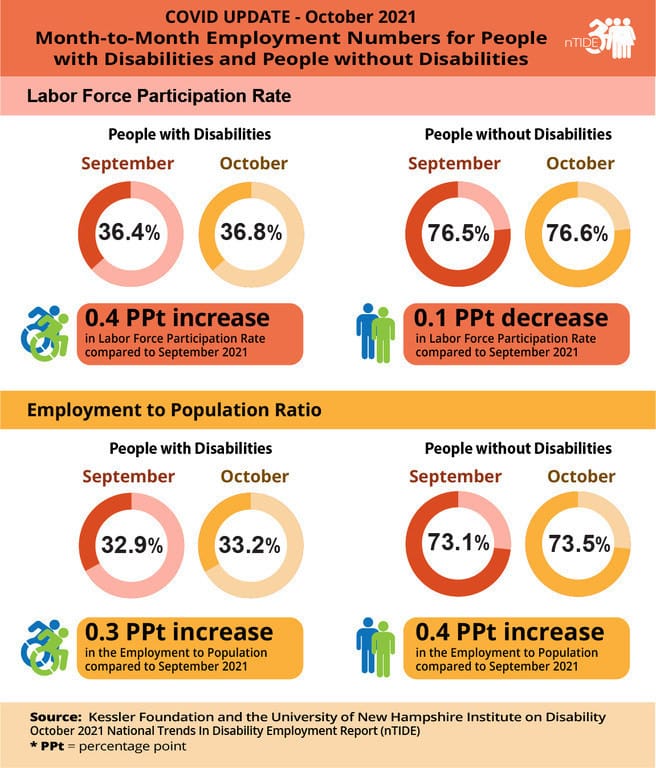In October, the major employment indicators for people with disabilities reached their highest recorded levels since September 2008, when reporting for this cohort was begun by the Bureau of Labor Statistics (BLS), according to the recently released National Trends in Disability Employment – Monthly Update (nTIDE), issued by Kessler Foundation and the University of New Hampshire’s Institute on Disability (UNH-IOD). Substantial gains were reflected in year-to-year comparisons, as well as for month-to-month data.
nTIDE COVID Update (month-to-month comparison)
In the recent BLS Jobs Report, the employment-to-population ratio for working-age people with disabilities increased from 32.9% in September 2021 to 33.2% in October 2021 (up 0.9% or 0.3 percentage points). For working-age people without disabilities, the employment-to-population ratio also increased from 73.1% in September 2021 to 73.5% in October 2021 (up 0.5% or 0.4 percentage points).
The employment-to-population ratio, a key indicator, reflects the percentage of people who are working relative to the total population (the number of people working divided by the number of people in the total population multiplied by 100).
“The employment of people with disabilities is pushing past historic levels, as well as pre-pandemic levels. The October 2021 employment-to-population ratio of 36.8 percent exceeds the September 2008 employment-to-population ratio of 32.7 percent,” he noted, “which is when the BLS first started to officially report employment figures for people with disabilities.”
— Andrew Houtenville, PhD, professor of economics and the research director of the University of New Hampshire’s Institute on Disability
The labor force participation rate for working-age people with disabilities increased from 36.4% in September 2021 to 36.8% in October 2021 (up 1.1% or 0.4 percentage points). For working-age people without disabilities, the labor force participation rate also increased from 76.5% in September 2021 to 76.6% in October 2021 (up 0.1% or 0.1 percentage points).
The labor force participation rate is the percentage of the population that is working, not working and on temporary layoff, or not working and actively looking for work.
“Over the last three months, we saw improvement in the labor force participation rate for people with disabilities. This may be a trend where people with disabilities are more comfortable returning to work as the COVID delta variant comes under control and employers continue to offer incentives to attract workers.”
– John O’Neill, PhD, director of the Center for Employment and Disability Research at Kessler Foundation

Year-to-Year nTIDE Numbers (comparison to the same time last year)
The employment-to-population ratio for working-age people with disabilities increased from 29.2% in October 2020 to 33.2% in October 2021 (up 13.7% or 4 percentage points). For working-age people without disabilities, the employment-to-population ratio also increased from 71.3% in October 2020 to 73.5% in October 2021 (up 3.1% or 2.2 percentage points).
The labor force participation rate for working-age people with disabilities increased from 33.3% in October 2020 to 36.8% in October 2021 (up 10.5% or 3.5 percentage points). For working-age people without disabilities, the labor force participation rate also increased from 76.2% in October 2020 to 76.6% in October 2021 (up 0.5% or 0.4 percentage points).
In October 2021, among workers ages 16-64, the 5,186,000 workers with disabilities represented 3.6% of the total 144,505,000 workers in the US.
NOTE: The statistics in the nTIDE are based on Bureau of Labor Statistics numbers but are not identical. They are customized by UNH to combine the statistics for men and women of working age (16 to 64). nTIDE is funded, in part, by grants from the National Institute on Disability, Independent Living and Rehabilitation Research (NIDILRR) (90RT5037) and Kessler Foundation.
[Source(s): Kessler Foundation, PR Newswire]
Related Content:
nTIDE September 2021 COVID Update: Unemployment Declines for Second Consecutive Month
September 2021 nTIDE: Job Numbers Surpass Pre-Pandemic Levels
nTIDE August 2021 Jobs Report: Job Numbers Show Resilience





